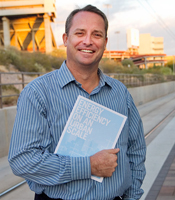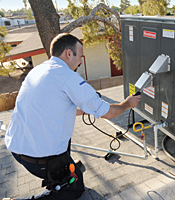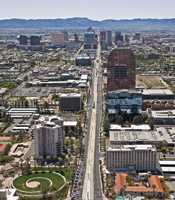November 30, 2011
Q&A with Mick Dalrymple

Mick Dalrymple

Duct sealing, air sealing, and HVAC replacement are three of the most effective residential energy upgrades.

The Energize Phoenix Corridor is a diverse area centered on the city’s Metro Light Rail.
Mick Dalrymple is the ASU project manager for Energize Phoenix, a $25 million federally funded program to upgrade the downtown Phoenix core for significant energy savings. He cofounded the Arizona chapter of the U.S. Green Building Council, served two terms on USGBC’s national board, and is a LEED Accredited Professional in both the Building Design & Construction and the Homes rating systems. Dalrymple is a graduate of the Thunderbird School of Global Management and ASU’s MBA program and has founded or cofounded three companies: a.k.a. Green Environmental Building Supplies, a.k.a. Green Services, and Desert Moon Productions. He also contributed to development of the ICC-700 National Green Building Standard.
How did sustainability become part of your career?
My career in sustainability was triggered by the release of the National Energy Policy plan in 2001, which depended heavily on continuing use of fossil fuels. Having grown up in a military family, I knew this plan would ultimately result in more U.S. troops being deployed to protect our energy interests abroad. As a former lobbyist for Arizona’s university students, I understood that change results from involvement. So I began working with others to create more sustainable solutions.
What is your most important sustainability-related project right now?
Energize Phoenix is a three-year incentive and education program focused on reducing energy waste in buildings. Energy efficiency is our single cheapest source of available “new” energy. Reducing wasted energy not only makes our businesses more competitive and our households more resilient, but it also reduces environmental impacts and reliance on other countries. Our goal is to trigger a substantial number of energy retrofits of homes and buildings and create a culture of energy efficiency along a ten-mile stretch of Phoenix’s light rail system. Such upgrades lowered energy consumption in my own home by 75 percent. The potential is enormous.
How will your work make a difference?
It is still early, but Energize Phoenix is already producing savings in 74 buildings and 302 apartments, while also providing lessons learned for the rapidly growing energy efficiency industry. In addition, our numerous lines of research will boost results for current and future energy efficiency programs. Our socio-behavioral research, for example, should improve the targeting of market-based energy efficiency programs. Meanwhile, our engineering research is working to increase the energy savings achieved through retrofits. And our economics research is tracking the energy and economic impacts of this program structure. We are also making a concerted effort to communicate research results to 40 other related programs across the country and to the U.S. Department of Energy.
What is the world sustainability challenge that concerns you most?
It’s the human issue. We have many sustainable solutions available that are not being implemented because we refuse to accept responsibility and deal with the problems we have created. We know the planet itself will go on regardless of what we do. We must collectively decide whether we value each other and our children enough to stay on board for the ride.
Note: The first year report on Energize Phoenix – Energy Efficiency on an Urban Scale – is available at energize.asu.edu.
November 30, 2011

